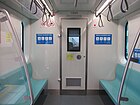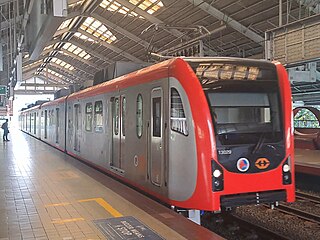
The Manila Light Rail Transit System, commonly known as the LRT, is an urban rail transit system that primarily serves Metro Manila, Philippines. Although categorized as a light rail system because it originally used light rail vehicles, it presently has characteristics of a rapid transit system, such as high passenger throughput, exclusive right-of-way, and later use of full metro rolling stock. The LRT is jointly-operated by the Light Rail Transit Authority (LRTA), a government corporation attached to the Department of Transportation (DOTr), and the Light Rail Manila Corporation (LRMC). Along with the Manila Metro Rail Transit System and the Metro Commuter Line of the Philippine National Railways, the system makes up Metro Manila's rail infrastructure.

The Metro Rail Transit Line 3, also known as the MRT Line 3, MRT-3, or Metrostar Express, is a rapid transit line in Metro Manila in the Philippines. The line runs in an orbital north to south route following the alignment of Epifanio de los Santos Avenue (EDSA). Despite its name, the line is more akin to a light rapid transit system owing to its tram-like rolling stock while having total grade separation and high passenger throughput. The line is officially known as the Yellow Line.

Construcciones y Auxiliar de Ferrocarriles is a Spanish publicly listed company which manufactures railway vehicles and equipment and buses through its Solaris Bus & Coach subsidiary. It is based in Beasain, Basque Autonomous Community, Spain. Equipment manufactured by Grupo CAF includes light rail vehicles, rapid transit trains, railroad cars and locomotives, as well as variable gauge axles that can be fitted on any existing truck or bogie.

The Light Rail Transit Authority (LRTA) is a public transport operator that is responsible for the construction, operation, maintenance and/or lease of Manila Light Rail Transit System in the Philippines. It is organized as a government-owned and controlled corporation under the Department of Transportation (DOTr) as an attached agency.

The Light Rail Transit Line 1, commonly referred to as LRT Line 1 or LRT-1, is a light rapid transit system line in Metro Manila, Philippines, operated by Light Rail Manila Corporation (LRMC) and owned by the Light Rail Transit Authority (LRTA) as part of the Manila Light Rail Transit System. Originally referred to as Metrorail and the Yellow Line, LRT Line 1 was reclassified to be the Green Line in 2012. It travels in a general north–south direction from Baclaran to Monumento, and then east–west from Monumento to Fernando Poe Jr. Currently, the line consists of 20 stations and runs on 19.65 kilometers of fully elevated route. Although it has the characteristics of light rail, such as with the type of rolling stock used, it is more akin to a rapid transit system owing to its total grade separation and high passenger throughput.

The Light Rail Transit Line 2, also known as LRT Line 2,LRT-2, or Megatren, is a rapid transit line in Metro Manila in the Philippines owned and operated by the Light Rail Transit Authority (LRTA). The line generally runs in an east–west direction between Recto in Manila and Antipolo. The line is officially referred to as the Purple Line.

La Brugeoise et Nivelles, later BN Constructions Ferroviaires et Métalliques, was a Belgian manufacturer of railway locomotives and other rolling stock; it was formed by a merger of two companies: La Brugeoise et Nicaise et Delcuve and Les Ateliers Métallurgiques de Nivelles.

Oaris is a modular high-speed train platform developed by the Spanish manufacturer CAF.
The CAF Urbos is a family of trams, streetcars, and light rail vehicles built by CAF. The Spanish manufacturer CAF previously made locomotives, passenger cars, regional, and underground trains. In 1993, CAF started building trams for Metrovalencia, with the delivery of 16 trams until 1999. This was a variant of a Siemens design and some components were delivered by Siemens, including bogies and traction motors. This design was also sold to Lisbon Trams in 1995; CAF then decided to design and build the Urbos in-house.
The Light Rail Transit Line 6 is a proposed rapid transit system in Cavite, Philippines. There have been two proposals for the line, with the first one shelved immediately in 2018. Another proposal emerged in 2017 and is currently under review by the National Economic and Development Authority (NEDA).

The MRTC 3000 class or ČKD Tatra RT8D5M LRV is a first-generation class of high-floor light rail vehicles built by Czech tram manufacturer ČKD Tatra. It is currently used on the Manila MRT Line 3 and were the last vehicles made by ČKD Tatra before it was taken over by Siemens.

The LRTA 1000 class is the first-generation class of high-floor light rail vehicles (LRV) currently operated by the Light Rail Manila Corporation. It first entered service under the Light Rail Transit Authority in 1984 on the LRT Line 1.
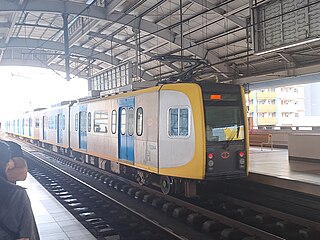
The LRTA 1200 class is the third-generation class of high-floor light rail vehicles (LRV) of the Light Rail Transit Authority servicing the Manila LRT Line 1. Purchased as part of the second phase of the capacity expansion of the line, the trains entered service in December 2006.
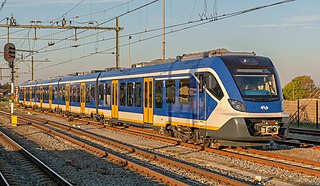
Sprinter New Generation or SNG: The Sprinter New Generation is an electrically driven type of trainset of the Dutch Railways or Nederlandse Spoorwegen. The trains are designed and built by the Spanish train builder Construcciones y Auxiliar de Ferrocarriles (CAF), who bases the trains on the Civity platform. The trains are primarily intended to replace older train equipment, but are also intended for the growth of the number of passengers on the Hoofdrailnet or main rail network.

The LRTA 2000 class is a class of electric multiple units of the Light Rail Transit Authority (LRTA) in Metro Manila, Philippines, which began operation in 2003. It is used in LRT Line 2.

The LRTA 1100 class is the second-generation class of high-floor light rail vehicles of the Light Rail Transit Authority (LRTA) in Manila, Philippines, which began operation in 1999.

The North–South Commuter Railway (NSCR) also known as the Clark–Calamba Railway, is a 147-kilometer (91-mile) urban rail transit system under construction in the island of Luzon in the Philippines. Running from New Clark City in Capas to Calamba, Laguna with 36 stations and four services, the railway is designed to improve connectivity within the Greater Manila Area, and it will be integrated with the railway network in the region.
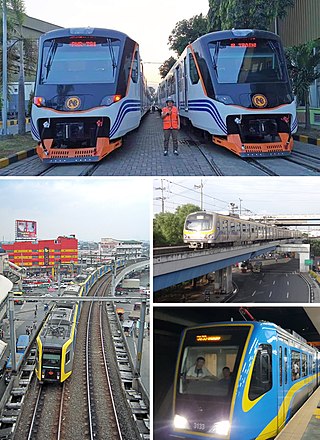
Rail transportation in the Greater Manila Area is a major part of the transportation system in Metro Manila and its surrounding areas. It consists of the Manila Light Rail Transit System, Manila Metro Rail Transit System, and the PNR Metro Commuter Line. The network makes up the majority of active railways in the country and bear the brunt of providing the metropolis with rail as a faster alternative mode of transport other than buses and jeepneys. However, these systems are currently insufficient for the rapidly expanding metropolis; to address this, new lines and line extensions are under construction, which will extend the system far out into neighboring regions.

The PNR EM10000 class is an electric multiple unit commuter trainset that will be operated by the Philippine National Railways on the North–South Commuter Railway. Prior to the reveal of its numbering scheme in October 2021, the train was known as the PNR Sustina Commuter. Set to enter service by 2023, it will be PNR's first trainset to be run on standard gauge and powered by electric traction. The trains are also designed to be interoperable with the Metro Manila Subway.
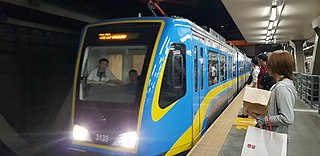
The MRTC 3100 class or CRRC Dalian 8MLB LRV, commonly called as the Dalian Train, is the class of second-generation uni-directional light rail vehicles built in China by CNR Dalian, now CRRC Dalian. Since its delivery, most of the trains are still being tested and undergoing final assessments, before being used on regular services on Line 3 of the Manila Metro Rail Transit System.







